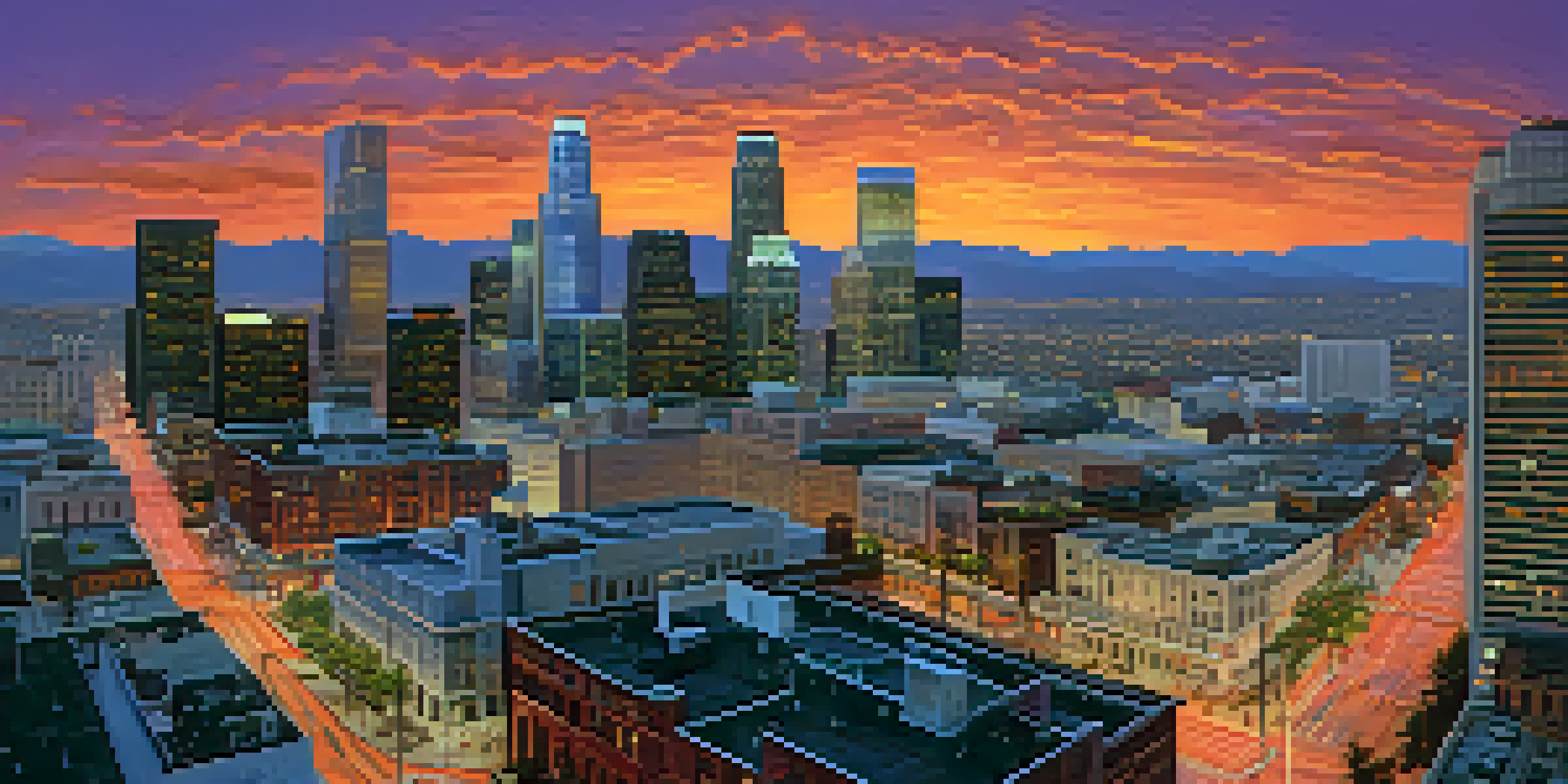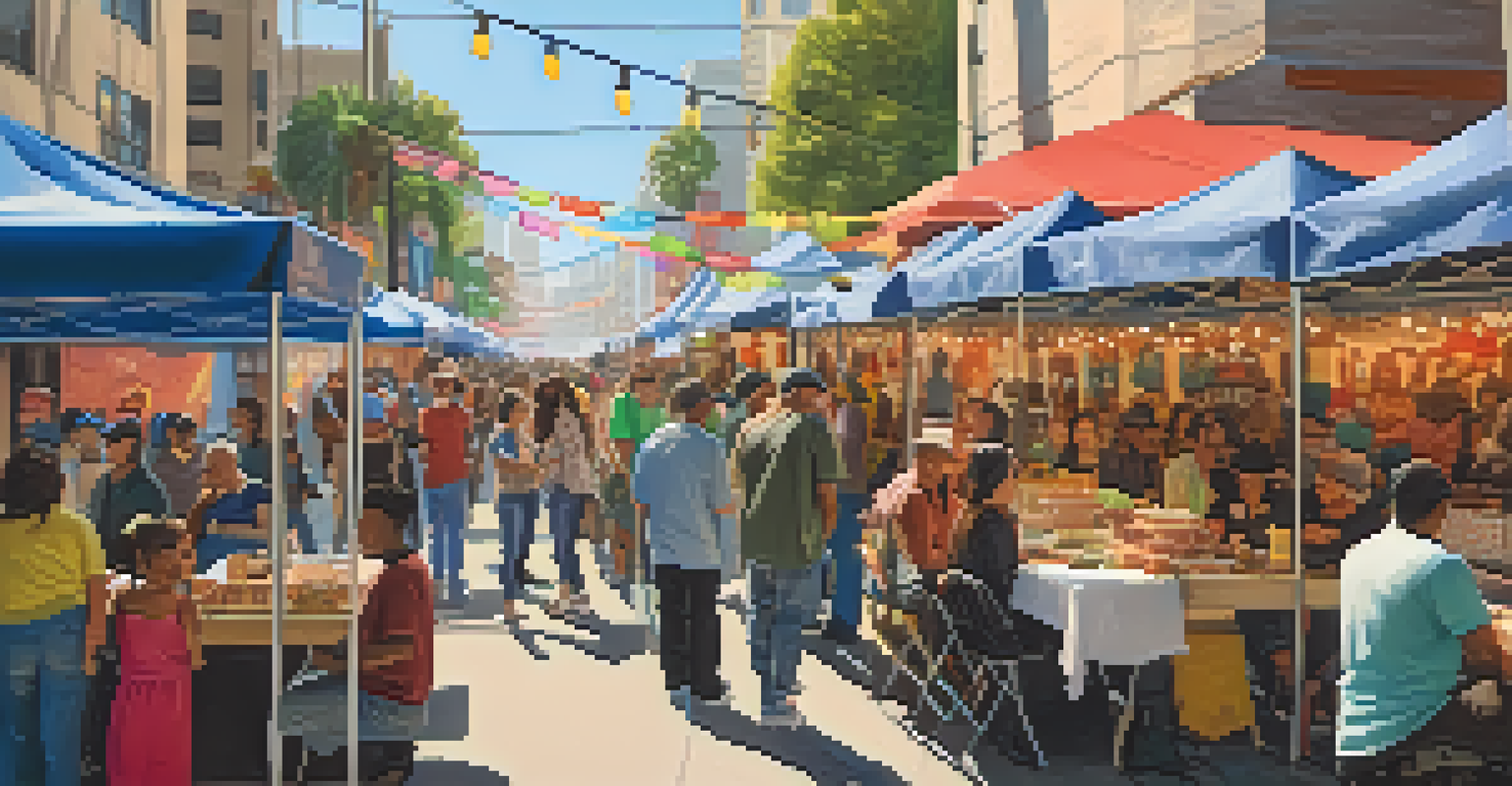The Origins of Downtown Los Angeles: A Historical Journey

The Early Beginnings of Los Angeles: A Native Perspective
Long before the city of Los Angeles was established, the area was inhabited by the Tongva people. These Indigenous tribes thrived in the rich landscapes, utilizing local resources for food, shelter, and community. Their deep connection to the land laid the foundation for what would later become a bustling urban center.
Los Angeles is a city of contrasts, where the old meets the new, and cultures blend seamlessly.
In 1769, Spanish explorers, led by Gaspar de Portolá, arrived in the region, marking the onset of European influence. They encountered the Tongva people and began establishing missions, which significantly impacted the local culture and demographics. The arrival of these explorers was a pivotal moment, setting the stage for future settlements.
By 1781, the Spanish officially founded the city of Los Angeles, initially named 'El Pueblo de Nuestra Señora la Reina de los Ángeles.' This marked a significant turning point, as the settlement began to grow, attracting settlers from various backgrounds, including Mexicans and Europeans. The early years were defined by agriculture, with settlers cultivating crops and raising livestock.
Mexican Rule and Transformation in the 19th Century
After gaining independence from Spain in 1821, Mexico took control of Los Angeles, leading to a period of significant change. The city experienced a cultural shift as Mexican traditions and governance influenced daily life. During this time, the population began to diversify, with many new settlers drawn to the area by its resources and opportunities.

The Mexican-American War (1846-1848) drastically altered the trajectory of Los Angeles. Following the war, the Treaty of Guadalupe Hidalgo ceded California to the United States, which further changed the political landscape. This transition marked the beginning of a new era, as American settlers began to flow into the region.
Indigenous Roots of Los Angeles
The Tongva people established deep connections to the land long before European explorers arrived, laying the groundwork for the city's future.
Throughout the late 1800s, Los Angeles experienced rapid growth, driven by the development of agriculture, railroads, and the burgeoning entertainment industry. The construction of the Southern Pacific Railroad in 1876 connected the city to the rest of the country, making it a prime destination for settlers and entrepreneurs alike.
The Rise of Industry and Urbanization in the Early 20th Century
As the 20th century approached, Downtown Los Angeles began to transform into an industrial hub. The discovery of oil in the region fueled economic growth, leading to the establishment of numerous refineries and manufacturing plants. This industrial boom attracted a large workforce, resulting in a population surge that forever changed the city's demographics.
In a city that is constantly evolving, it is the spirit of community and creativity that binds us.
The construction of iconic landmarks, such as the Bradbury Building and the Los Angeles City Hall, symbolized this rapid urbanization. These architectural marvels showcased the city's ambition and creativity, contributing to its unique skyline. Downtown became a vibrant center of commerce and culture, where business and art coexisted.
Additionally, the rise of the film industry in Hollywood, just a short distance away, further boosted the local economy. The allure of the silver screen drew talent and audiences alike, solidifying Los Angeles as a cultural powerhouse. This era laid the groundwork for the city's reputation as a global entertainment capital.
Cultural Diversity and Social Change in the 1960s
The 1960s were a defining decade for Downtown Los Angeles, marked by cultural diversity and social movements. The city became a melting pot of different ethnicities and cultures, each contributing to the unique tapestry of urban life. This diversity enriched the community, fostering a sense of vibrancy that is still felt today.
During this period, significant social changes were underway, particularly in response to civil rights movements across the nation. Activists in Los Angeles advocated for equality and justice, drawing attention to issues such as housing, education, and fair employment. These movements played a crucial role in shaping the cultural landscape of the city.
Cultural Shifts During Mexican Rule
Following Mexico's independence in 1821, Los Angeles experienced significant cultural changes that diversified its population and shaped its identity.
As communities united to fight for their rights, Downtown Los Angeles became a focal point for protests and demonstrations. The spirit of activism fostered a sense of solidarity among the diverse populations, reinforcing the importance of community engagement in the pursuit of social change.
Revitalization Efforts: The Turn of the 21st Century
Entering the 21st century, Downtown Los Angeles underwent significant revitalization efforts aimed at breathing new life into the area. With a focus on urban renewal, city planners and developers sought to transform neglected spaces into thriving neighborhoods. This wave of revitalization attracted new residents and businesses, fostering a sense of community.
Projects like the LA Live complex and the restoration of historic buildings contributed to the area's renewed vibrancy. These efforts not only enhanced the aesthetic appeal of Downtown but also created new opportunities for entertainment, dining, and cultural experiences. The revitalization attracted both locals and tourists, eager to explore the evolving landscape.
Moreover, initiatives to improve public transportation, such as the expansion of the Metro system, made Downtown more accessible. This connectivity encouraged people to explore the area, further enriching its cultural and economic landscape. The combination of historic charm and modern development has positioned Downtown Los Angeles as a desirable place to live, work, and visit.
The Role of Arts and Culture in Shaping Downtown Identity
Arts and culture have played a pivotal role in shaping the identity of Downtown Los Angeles. With a rich history of creativity, the area has become a hub for artists, musicians, and performers. The presence of institutions like The Broad Museum and the Walt Disney Concert Hall reflects the city's commitment to fostering artistic expression.
The vibrant arts scene not only enriches the community but also attracts visitors from around the world. Festivals, street art, and live performances breathe life into the streets, creating a dynamic atmosphere that's hard to resist. This cultural infusion has become a defining characteristic of Downtown Los Angeles.
Revitalization and Modern Growth
At the turn of the 21st century, Downtown Los Angeles embraced revitalization efforts that transformed neglected areas into vibrant neighborhoods, attracting residents and businesses alike.
Furthermore, the intersection of culture and commerce has led to unique partnerships, where businesses support local artists and events. This collaboration fosters a sense of belonging and pride among residents, reinforcing the idea that Downtown is more than just a place—it's a community that celebrates creativity and diversity.
A Bright Future: The Evolving Landscape of Downtown Los Angeles
As we look to the future, Downtown Los Angeles continues to evolve, embracing change while honoring its rich history. The community remains committed to sustainable development, ensuring that growth benefits all residents. This forward-thinking approach aims to create a vibrant urban environment where everyone can thrive.
With ongoing projects focused on affordable housing, green spaces, and public amenities, the city is working to address the challenges of urban living. These initiatives aim to make Downtown a more inclusive and accessible place for all. The commitment to sustainability reflects a broader trend towards responsible urban development.

Ultimately, the story of Downtown Los Angeles is one of resilience and transformation. As the city grows and adapts, it draws on its diverse heritage to create a future that honors its past while looking forward. The journey of Downtown is far from over, and its vibrant spirit will undoubtedly continue to inspire generations to come.